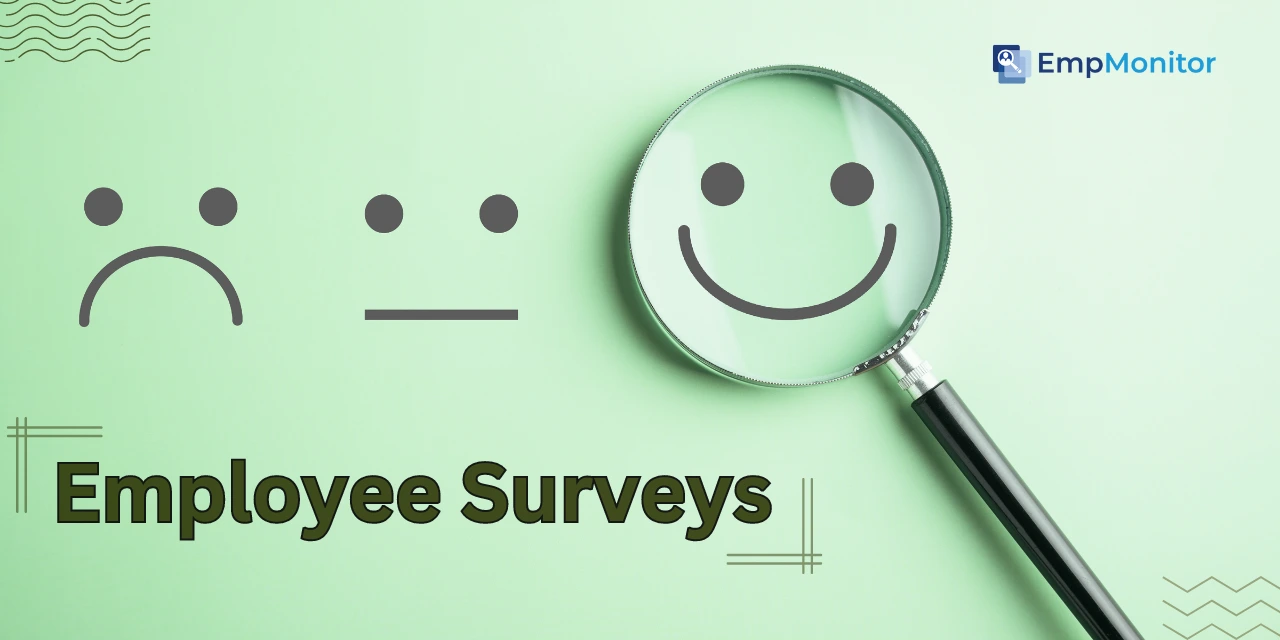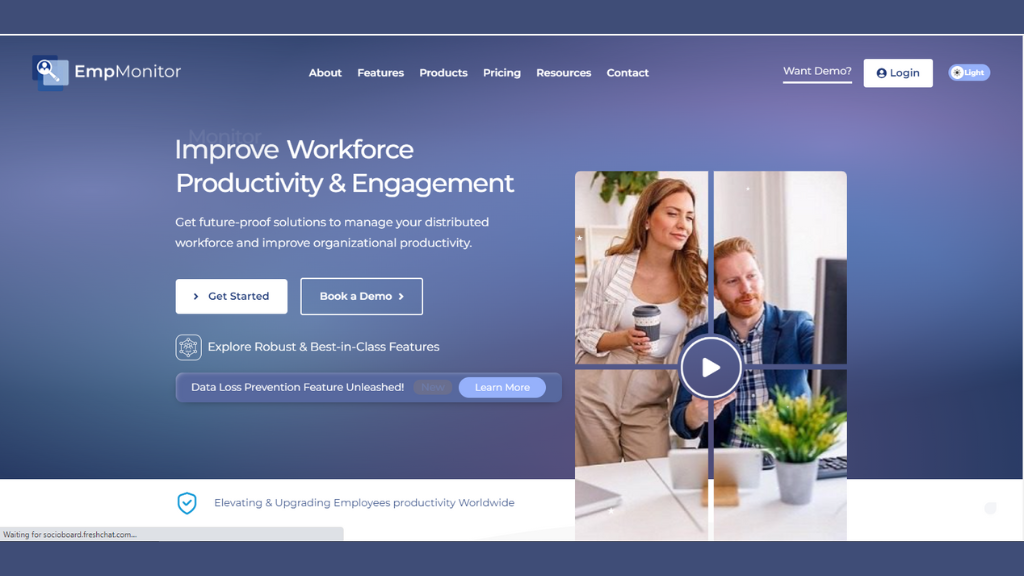To cultivate a vibrant and involved workforce, companies frequently utilize employee surveys as indispensable instruments to grasp the dynamics within their teams. These surveys offer an organized avenue for collecting information on job contentment, levels of engagement, and potential areas for enhancement.
In this blog, we will familiarize ourselves with seven employee surveys examples and understand how to conduct them accurately.
In addition to gathering opinions and assessments about employee mood, morale, and engagement, employee surveys also monitor the performance of the employees.
Frequently employed by HR and management, these surveys maintain anonymity, encouraging employees to share their work experiences. Using these survey examples, organizations can gain practical insights, fostering continuous improvement and safeguarding employee welfare.
To understand these, we must comprehend the various types of employee surveys in the business circle before learning how to do these surveys. Let us know them first.
In a hurry? Listen to the blog instead!
Types Of Employee Surveys:
There are various types of employee surveys that employers use to track the overall health of employees and the organization as well. Here, we will discuss the most utilized surveys through employee surveys examples.
They are:
- Employee Satisfaction Survey
- Employee Culture Survey
- Employee Engagement Survey
- Leadership Effectiveness Survey
- Work-Life Balance Survey
- Training and Development Needs Assessment
- Communication Effectiveness Survey
- Diversity and Inclusion Survey
Employers can obtain a comprehensive overview of their company’s health through these various survey methods.
Let’s explore the types of employee surveys with employee surveys examples.
Types Of Employee Surveys Examples:
It is vital to conduct effective employee surveys to gain insight into your employees’ satisfaction, engagement, and overall well-being.
Here are eight employee survey types with employee surveys examples that can give you an idea of how to structure and implement them properly in your surveys:
Employee Satisfaction Survey:
The Employee Satisfaction Survey plays a crucial role among various employee surveys examples. Assessing employee satisfaction and identifying areas for improvement are its main objectives.
Through thoughtfully designed questions, these employee wellness programs explore different aspects of the work experience, enabling organizations to understand satisfaction levels and identify practical steps for enhancement.
This proactive strategy reinforces employee well-being and demonstrates a dedication to ongoing improvement in the workplace environment.
Examples of these are:
- How would you rate your current level of satisfaction with your role on a scale from 1 to 10?
- What aspects of your job do you find most satisfying?
- Are there any specific challenges or concerns affecting your job satisfaction?
Employee Culture Survey:
An employee culture survey is a type of employee survey that assesses the prevailing values, beliefs, and behaviors within an organization. It evaluates the cultural elements influencing teamwork, communication, and leadership philosophies in the workplace.
It is one of the many employee surveys examples. Organizations gain insights into the existing culture through this survey, helping them identify strengths and areas for improvement and fostering a more positive and aligned workplace culture.
Its examples are:
- Do you feel like your work is respected?
- What would make the company a better workplace?
- Are you a happy employee?
- Do you like the atmosphere at the company?
Employee Surveys Examples In Employee Engagement:
The Employee Engagement Survey stands as a prominent example of an employee surveys examples. With a focused objective, it tries to evaluate the extent of employee engagement and their commitment to the organization.
By illuminating levels of engagement, organizations can institute targeted strategies to bolster commitment, fostering a workplace environment that not only values its employees but actively involves them in the organizational journey.
Examples of these are:
- How motivated do you feel to contribute to the success of the company?
- Do you feel your work is recognized and appreciated?
- What factors contribute to your sense of belonging in the organization?
Leadership Effectiveness Survey:
The Leadership Effectiveness Survey is prominent among various employee surveys examples. With a distinct purpose, it seeks to examine and evaluate the effectiveness of leadership within the organization.
Through focused employee surveys questions, this survey aims to gauge communication, support, and guidance from leadership. By addressing these crucial elements, organizations can identify areas for enhancement, fine-tune leadership approaches, and strengthen overall leadership effectiveness.
It underscores a dedication to fostering supportive and empowering work.
Here are some examples:
- How would you rate the communication skills of your immediate supervisor?
- Do you feel supported by your manager in achieving your career goals?
- Are there areas where leadership could improve in your department?
Work-Life Balance Survey:
The Work-Life Balance Survey is a relevant illustration within the spectrum of employee surveys examples, designed to understand employees’ views on their work-life equilibrium.
Through specific questions, this survey seeks insights into challenges employees encounter in balancing professional and personal aspects. By grasping their perspectives, organizations can introduce initiatives that improve work-life balance, fostering employee well-being.
Examples of these are:
- How frequently do you experience a sense of being overwhelmed by your workload?
- Do you feel that your work demands interfere with your personal life?
- Are there any specific initiatives or changes that could improve your work-life balance?
Training and Development Needs Assessment:
The training and development needs assessment plays a pivotal role in employee surveys, targeting a specific objective: recognizing areas where employees express a demand for additional training and development.
This survey aims to identify particular knowledge or skill gaps in the workforce by providing targeted questions. The insights garnered enable organizations to tailor training programs effectively, aligning them with employees’ professional aspirations and organizational needs.
It exemplifies a proactive commitment to continuous improvement and employee growth, showcasing the organization’s responsiveness to evolving skill requirements.
These are some examples:
- Are you satisfied with the training opportunities provided by the company?
- What skills or knowledge gaps do you feel exist in your current role?
- How can the organization better support your professional development?
Communication Effectiveness Survey:
The Communication Effectiveness Survey is one of the many employee surveys examples. Its main goal is to check how well communication works inside a company. It asks employees about how clear and easy-to-use communication is.
By knowing what employees think, the company can improve its communication process, making the workplace more transparent and informed.
The results of this survey demonstrate a desire to improve communication, which increases employee engagement and improves overall organizational performance.
Examples of this type of survey are:
- How well do you feel informed about company updates and changes?
- Are there communication channels that you find more effective than others?
- Do you have suggestions for improving internal communication within the organization?
Diversity and Inclusion Survey:
The Diversity and Inclusion Survey serves as a crucial example within the spectrum of employee surveys, targeting the specific objective of evaluating an organization’s dedication to diversity and inclusion.
With precision crafting, the survey seeks employees’ views on the company’s diversity efforts. By measuring employee engagement and examining the data from this survey, companies can create inclusive plans, demonstrating a commitment to equality in employee surveys.
Its examples are:
- Do you feel that diversity is valued and promoted within the company?
- Have you experienced or witnessed any instances of discrimination in the workplace?
- What initiatives would you suggest to enhance diversity and inclusion?
These types of surveys can help to conduct a successful employee survey.
Let us now understand how to conduct these surveys with employee surveys examples.
Also Read:
Measuring Employee Engagement: Why It Matters and How to Do It Right
Ultimate Guide To Employee Engagement Tools
07 Wellness Programs To Fosters Employee Productivity
How To Conduct Proper Employee Surveys:
It is vital to conduct these surveys properly to ensure that they work.
Here are the tips to enable you to do employee surveys properly:
Keep it anonymous and private:
Employees should feel safe giving honest feedback without worrying about any backlash. So, avoid asking for their names or any other identifying details.
Ask straightforward questions:
Ensure the questions are clear and easy to understand. Avoid questions that are too broad or complicated.
Offer different ways to respond:
It may be more convenient for some employees to give an online survey, while others may prefer to fill out a paper survey. Giving options increases participation.
Give rewards for taking part:
Offering incentives like gift cards or extra time off can motivate employees to join in.
Use the results to make improvements:
After the survey, analyze the feedback and make meaningful changes based on what you find, like fixing problems or introducing new policies.
The purpose of conducting employee surveys is to enhance employee engagement.
Taking assistance from employee monitoring software such as EmpMonitor can help in measuring employee engagement.
Let us learn more about this powerful employee management tool.
EmpMonitor- The Leading Employee Management Software
EmpMonitor is the top workforce management and time tracking software, simplifying tracking and boosting productivity. It monitors work hours, websites visited, and tasks completed to streamline operations.
With easy-to-use features, it enhances efficiency and ensures accountability. EmpMonitor empowers businesses to manage their workforce effectively, leading to success and growth.
It tracks various employee activities, providing insights into their work patterns, productivity, and engagement levels. Organizations can make data-driven decisions to improve employee satisfaction and productivity by monitoring tasks, time spent on projects, and interactions.
Some other features of EmpMonitor are:
Productivity Analysis: Using this feature, you can check how productive your team is, as it shows employees working hours on different tasks and projects.
Screenshots: Another feature of EmpMonitor is that it takes the screenshots of employees screens at intervals so managers can see what they are working on.
Time Tracking: It also records employees working hours- helping managers understand where time is going.
Attendance Logs: It creates the attendance log report of employees, from their check-in to their check-out times on their computers.
Remote Monitoring: Empmonitor allows managers to monitor employees’ activities even if they’re working from home or in a different location.
Stealth Mode: It can run discreetly in the background without employees knowing they’re being monitored.
It is the best software for managers to keep track of the engagement of employees and monitor their performance. Managers can easily judge the mindset of the employees based on these results, and it can assist them in their surveys of employees and increase employee engagement.
Concluding Words:
When administering employee surveys, prioritize anonymity for candid feedback. Regularly analyze and act on results and showcase an unwavering commitment to continuous improvement and employee well-being.
By exploring diverse workforce surveys, you can highlight their vital role in guiding organizations toward meaningful enhancements and fostering environments that prioritize well-being and engagement.
The diverse array of employee surveys examples reflects a commitment to understanding, adapting, and valuing the workforce. Survey insights drive organizations towards a future where employees are essential elements in shaping positive workplace cultures.















